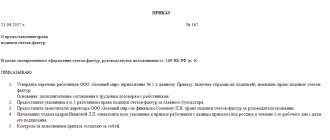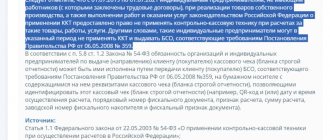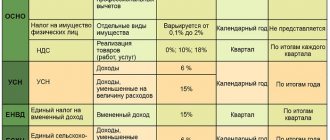From July 1, 2020, new forms of invoice and adjustment invoice have been introduced. A new requisite “Government Contract Identifier” has appeared.
Decree of the Government of the Russian Federation dated December 26, 2011 No. 1137, which is responsible for the form of the invoice, has been updated (Resolution of the Government of the Russian Federation dated May 25, 2017 N 625). Let's look at the innovations regarding the issuance of paper invoices.
Main change : Added new line 8 “Identifier of government contract, agreement (agreement)” for the invoice (UPD) and similar data is reflected in line 5 of the adjustment invoice. This detail is indicated only if the Organization works under government contracts and such a code is assigned to the contract.
and samples of filling from 07/01/2017:
- Invoice;
- Adjustment invoice;
- Universal transfer document (UDD).
What are invoices for: basic knowledge
An invoice is a documentary basis for the buyer to accept the VAT amounts presented by the seller for deduction (refund). This follows from paragraph 1 of Article 169 of the Tax Code of the Russian Federation. Tax legislation requires an invoice to be issued every time you sell goods, work, services or property rights. Invoices can be generated on paper or electronically. The paper form and the rules for filling it out are defined in Appendix No. 1 to Decree of the Government of the Russian Federation of December 26, 2011 No. 1137.
Decree of the Government of the Russian Federation dated December 26, 2011 No. 1137 approved the current forms and Rules for filling out (maintaining) the following documents used in VAT calculations:
- invoices (Appendix No. 1);
- adjustment invoice (Appendix No. 2);
- log of received and issued invoices (Appendix No. 3);
- purchase books (Appendix No. 4);
- sales books (Appendix No. 5).
If the seller wishes to send invoices to buyers electronically, the buyer is required to agree to this. At the same time, the means of receiving, exchanging and processing invoices electronically between the seller and the buyer must be compatible. They must comply with the established formats (paragraph 2, paragraph 1, article 169 of the Tax Code of the Russian Federation). Invoices are issued and received electronically in the manner approved by Order of the Ministry of Finance of Russia dated November 10, 2015 No. 174n.
New form of invoice journal, purchase and sales ledger
From October 1, new forms of the log of received and issued invoices, purchase books and sales books will be put into effect, and the procedure for filling them out will also be clarified. The new forms are subject to mandatory use by all organizations and individual entrepreneurs that carry out VAT transactions.
The amendments determine that the log of received and issued invoices is kept only by intermediaries who act on the basis of commission agreements, agency agreements providing for the sale and purchase of goods on behalf of the commission agent or agent. Also, the journal must be kept when executing transport expedition contracts, as well as when performing the functions of a developer.
The journal reflects only information about goods and services sold as part of intermediary transactions. That is, if the invoice contains your own goods and goods sold under commission agreements, you only need to enter data in the journal for the second group of goods.
At the same time, cases are clarified when intermediaries do not have to keep a logbook. Since October, the log is not kept in the following cases:
- sales of goods and services by a commission agent (agent) to buyers who are exempt from VAT;
- sales of goods and services by a commission agent (agent) to foreign buyers.
Invoices from October 1st are recorded in the accounting journal for the period in which the transaction occurred, and not in the period in which they were received or issued.
Also, from October 1, the form of the purchase and sales book and the procedure for filling them out will change. Additional columns 3a and 3b will appear in the sales book. They will need to indicate the registration number of the customs declaration and the code of the type of goods according to the Commodity Nomenclature of Foreign Economic Activity of the EAEU, respectively. Line 3a is filled out by residents of the SEZ in the Kaliningrad region in accordance with subparagraph 11 of paragraph 1 of Article 151 of the Tax Code of the Russian Federation. And line 3b is filled in by analogy with invoices only in the case of sales to the EAEU countries.
The names of some columns in the purchase book have been changed. Instead of the column “Information about the intermediary (commission agent, agent),” from October there will be a column “Information about the intermediary (commission agent, agent, forwarder, person performing the functions of the developer).” Instead of the column “Customs declaration number”, you will need to fill in the column “Registration number of the customs declaration”.
Another change to the invoice form
The last time the invoice form changed was relatively recently - from July 1, 2020. By Decree of the Government of the Russian Federation dated May 25, 2017 No. 625, changes were made to the forms of invoices and adjustment invoices. From July 1, 2020, the invoice form was supplemented with line 8 “Identifier of the government contract, agreement (agreement).” The adjustment invoice, in turn, was supplemented with a new line 5 with the same name. We talked about this in detail in the article “Invoice from July 1, 2020: new form and format.”
From October 1, 2020, the invoice form has changed again. Now the amendments are provided for by Decree of the Government of the Russian Federation dated August 19, 2017 No. 981. You can download this document from the link.
Innovations by address
Changes have been made to the rules for filling out invoices to clarify the indication of addresses. In lines 2A and 6A you should indicate not the address of the location, but the address of the register's specifications. For companies this is the address indicated in the Unified State Register of Legal Entities, and for entrepreneurs - in the Unified State Register of Legal Entities. The same rules apply to commission agents (agents), as well as principals (principals), who draw up invoices for commission agents (agents) selling their goods on their own behalf.
Special rules for indicating addresses in invoices were established for tax agents from paragraphs 2 and 3 of Article 161 of the Tax Code of the Russian Federation. They had to indicate as the address the location of the seller or lessor for whom the tax was paid. Now this procedure has been preserved only for tax agents who, on the territory of Russia, purchase goods and services from foreign legal entities that do not have a local representative office (clause 2 of Article 161).
But for taxpayers who perform such duties on the basis of paragraph 3 of Article 161 of the Code, the rules have changed. The mentioned paragraph deals with the rental and purchase of state property. The tenant plays the role of a tax agent - calculates, withholds and pays tax amounts to the budget. Now he is obliged to indicate when issuing an invoice the address of the lessor, reflected in the Unified State Register of Legal Entities.
In addition, the rules for storing invoices and other VAT documents have changed.
How the filling rules have changed
In addition to the actual form of the invoice form, from October 1, 2017, the rules for filling out this document have also changed. There are quite a few amendments in this part. Let's list the most important ones.
The seller's address must be indicated in accordance with the Unified State Register of Legal Entities or Unified State Register of Entrepreneurs
As of October 1, 2017, changes have been made to the procedure for filling out line 2a of the invoice. Currently, this line indicates the location of the seller-organization in accordance with the constituent documents or the place of residence of the seller-individual entrepreneur. From 01.10.17, in line 2a it will be necessary to indicate the address of legal entities specified in the Unified State Register of Legal Entities, or the place of residence of an individual entrepreneur indicated in the Unified State Register of Legal Entities. You can check the address in the register on the official website of the Federal Tax Service using a special service. Here is the link. Also see “Exclusion of legal entities from the Unified State Register of Legal Entities from September 1, 2020.”
Even before October 1, 2020, we recommend that the invoice reflect the postal code, name and type of subject of the Russian Federation, name of the locality, street, house number, building, building. This data should be entered for both the buyer and the seller.
Rules for forwarders have appeared
From October 1, 2020, the procedure for filling out an invoice has been supplemented with new provisions. They are used in cases where the invoice is drawn up by a freight forwarder, a developer or a customer performing the functions of a developer when purchasing property rights from one or more sellers of goods (works, services) on its own behalf.
So, in particular, from October 1, 2020, the procedure for drawing up invoices for forwarders who organize transportation using third-party companies was prescribed. Before this there were no rules for them. Therefore, forwarders filled out invoices according to the rules established for commission agents (letter of the Ministry of Finance of Russia dated January 10, 2013 No. 03-07-09/01).
A freight forwarder who organizes transportation using third-party carriers has the right to prepare “consolidated” invoices. In them, he reflects the data of invoices received from performing carriers. According to the new rules, from October 1, 2020, a freight forwarder who makes purchases on its own behalf at the client’s expense will have to indicate in “consolidated” invoices:
- in line 1 - the date and number of the “consolidated” invoice according to the chronology of the forwarder;
- in line 2 - full or abbreviated name of the seller (forwarder), full name of the entrepreneur (forwarder);
- in line 2a – the forwarder’s address;
- in line 2b - INN and KPP of the seller (forwarder);
- in line 5 - details (number and date of preparation) of payment and settlement documents indicating that the forwarder transferred money to the sellers, and the client - to the forwarder - through the sign “;”;
- in column 1 - names of goods (works, services) in separate positions for each seller;
- in columns 2–10 - for each seller, data from the invoices they issued to the forwarder.
From October 1, 2020, freight forwarders can issue consolidated invoices. In the consolidated invoice, in the lines “Seller”, “Address”, “TIN/KPP” of the seller, you can indicate your own data. That is, the data of the forwarder, and not of third parties providing services to the forwarder.
The price is determined by calculation: how to fill out an invoice
Sometimes accountants were faced with the question of how to fill out invoices if the contract price was determined by calculation. This question is relevant when the price of a product (work, service) is the difference between the cost including VAT and the amount of VAT. The Rules for filling out an invoice from October 1, 2020 explain that in these cases, column 4 of the invoice is the difference between columns 9 and 8. Use this approach to filling out column 4 if:
- property was sold that was taken into account during the purchase, including VAT (clause 3 of Article 154 of the Tax Code of the Russian Federation);
- sold agricultural products purchased from individuals (clause 4 of article 154 of the Tax Code of the Russian Federation);
- sold cars previously purchased from individuals (clause 5.1 of Article 154 of the Tax Code of the Russian Federation);
- transferred property rights (clauses 1–4 of Article 155 of the Tax Code of the Russian Federation).
Changes in the rules for issuing invoices
In addition to changes in the names of sections and lines of invoices, the requirements for filling them out have also changed.
Seller's address. In line “2a” you need to indicate the address of the seller that is indicated in the Unified State Register of Legal Entities or the Unified State Register of Individual Entrepreneurs. According to the old rules, the actual address was indicated in this column; now it is necessary to enter the address specified when registering a legal entity, and necessarily with a postal code.
Summary invoice. Innovations have been added for freight forwarders and developers. Their essence is as follows: if the forwarder involves third parties in the transportation, he can draw up a “consolidated” invoice, which includes the data of invoices received from the forwarding agents. From October 1, 2017, the forwarder fills out the “summary” document as follows:
- in line 1 the number of the “summary” document and the date are written according to its own chronology;
- in lines “2”, “2a” and “2b” the forwarder indicates his data;
- the name of the product is indicated separately for each seller in column “1”;
- Columns 2-10 contain data from invoices issued by sellers to the forwarder.
Developers register in separate positions in column 1 all construction and installation work, goods, services in accordance with the invoices issued to them by suppliers.
How the form of the adjustment invoice has changed
The Tax Code of the Russian Federation establishes the obligation to issue adjustment invoices (paragraph 3, clause 3, Article 168 of the Tax Code of the Russian Federation). Sellers of goods (works, services) exhibit them in the event of an adjustment to the cost of shipped goods (work performed, services rendered) or transferred property rights. This can happen when, for example, the price or quantity (volume) of goods (work, services), property rights changes.
From October 1, 2020, column 1b for the product type code was added to the adjustment invoice form. It will be filled out by organizations that export goods to the EAEU countries.
Also, from this date, additional lines and columns were officially allowed to be added to the adjustment invoice (in particular, details of the primary invoice). However, the basic form of the adjustment invoice must remain the same.
a new form for an adjustment invoice from October 1, 2017 in Word format.
a new form for an adjustment invoice from October 1, 2017 in Excel format.
What has changed in the new invoice?
The main changes concern four points in the document; let’s look at them in more detail.
Firstly , in line “8”, where the identifier of the government contract/agreement should be indicated, the phrase “if available” has appeared. This is a technical change that does not affect the rules for filling out the document, but only clarifies that the identifier should be indicated if available.
The second innovation concerns suppliers who export goods to Belarus, Kazakhstan, Kyrgyzstan, and Armenia (EAEU). In the new form, column “1a” has appeared, in which you need to enter the code of the type of product, according to the Commodity Nomenclature of the EAEU. In previous versions of the invoice, this code was printed in one column with the name of the product. The same innovation also changed the form of the adjustment invoice. Now column “1b” has appeared there for making a similar entry.
The third change was the name of column 11. Previously, this column was called “Customs Declaration Number”, now officials have made a clarification, and the column is called “Customs Declaration Registration Number”. Let's remember: these are different numbers. In column 11, enter the number assigned to the document by the responsible representative of the customs authority. This requirement applies to goods manufactured outside the Russian Federation.
Fourth change. If the previous changes concerned organizations working under government contracts and conducting foreign trade activities, then the final point applies to all individual entrepreneurs. Previously, the entrepreneur had to sign the invoice himself, but now an authorized person can do this for him. The signature line is now called “Individual entrepreneur or other authorized person.” Authorized persons include those who have a power of attorney to sign, certified by a notary.
New rules for storing invoices
From October 1, 2020, the rules for storing invoices will be clearly established. It will be necessary to store them in chronological order as they are exhibited (compiled, corrected) or received. A similar storage approach will apply to electronic document management operator confirmations and notifications to customers of receipt of invoices. All types of invoices (initial adjustment and corrected) will need to be kept for four years. Copies of paper invoices received from intermediaries must be certified by their signatures (principals, principals, developers or forwarders).
If you find an error, please select a piece of text and press Ctrl+Enter.
Changes in invoices: what a “simplified” person needs to know
It would seem, why would a “simplified” person know about the changes associated with invoices? But in practice, “simplifiers” work with foreign counterparties that do not have a permanent representative office in Russia, or they rent state property. At the request of the counterparty, a company or individual entrepreneur using the simplified tax system can simply submit an invoice.
The currently used invoice form is established by Decree of the Government of the Russian Federation dated December 26, 2011 No. 1137. Invoices can be generated on paper or electronically. But most companies, the old-fashioned way, generate paper invoices due to the fact that not all counterparties have switched to electronic document management.
But at the same time, taxpayers are constantly faced with changes made to the procedure for using invoices. Thus, the procedure for issuing invoices in electronic form was approved by Order of the Ministry of Finance of Russia dated November 10, 2015 No. 174n. The form and format of the document changes quite often, for example, the previous form of the invoice was valid from July 1, 2020.
GOOD TO KNOW
From October 1, 2020, by Decree of the Government of the Russian Federation dated August 19, 2017 No. 981, changes were made to the forms of invoices, the journal of received and issued invoices, purchase and sales books. The rules for filling and storing them have been adjusted.
What has changed in the new form?
1. Product type code.
A new column 1a “Product Type Code” has appeared; the above field is filled in by organizations that export goods from Russia to the EAEU countries. This code is taken from the Unified Commodity Nomenclature for Foreign Economic Activity of the EAEU. If the company does not carry out foreign economic activity or if there is no data on the product code, a dash is entered.
Example.
2. Signing the invoice.
Often the invoice is signed by a storekeeper, accountant, driver, or other person who either accepts the goods or prepares the primary documents. In medium-sized and large companies, managers almost never sign invoices, this is understandable: the CEO or director usually develops the company’s strategy and negotiates with counterparties. But at the same time, they delegate the authority to sign invoices to other persons. Tax authorities take advantage of this to assess additional taxes, declaring that invoices were signed by unidentified persons.
Now in the invoice there is a line “other authorized person” for signature instead of an individual entrepreneur. In the previous version of the invoice dated July 1, 2017, this column was only under “head of organization” and “chief accountant.” This change is positive because in practice anyone can sign an invoice.
Example.
3. Registration number of the customs declaration.
In letter dated August 30, 2013 No. AS-4-3/15798, the Federal Tax Service of Russia provided recommendations related to the reflection of the customs declaration number in the invoice.
So, in their opinion, in column 11 of the invoice you need to indicate the customs declaration number, consisting of the following two elements, separated by a fraction sign:
1) registration number of the customs declaration. It is assigned by an official of the customs authority of the Russian Federation when accepting a customs declaration and is indicated in the first line of column “A” of the main and additional sheets;
2) serial number of the product. This number is reflected in column 32 of the main or additional sheet of the customs declaration. If a list of goods was used when declaring instead of additional sheets, then the number in question is in the corresponding list.
For example, if in the first line of column “A” of the customs declaration the number “10226010/220211/0003344” is indicated, and the product number in its column 32 is “1”, then in column 11 of the invoice you need to enter the value “10226010/220211/0003344 /1".
Now the company is required to indicate the customs declaration number in a special column.
4. Indication of the address.
Addresses are often the cornerstone of disputes with the tax office.
It is assumed that the address indicated in the Unified State Register of Legal Entities is the address at which the company can be contacted by mail or at which its representative is located. And all messages delivered to this address are a priori considered received by the company, even if it is not located there. Now the addresses on invoices must also match the legal addresses.
In the “Address” line (2a) of new invoices from 10/01/2017 you must indicate:
- for a legal entity - the address specified in the Unified State Register of Legal Entities;
- for individual entrepreneurs – the individual entrepreneur’s place of residence in accordance with the Unified State Register of Individual Entrepreneurs.
Currently, in the invoice dated 07/01/2017, this line must indicate:
- for a legal entity - actual location address;
- for individual entrepreneurs – address of actual residence.
However, this innovation may cause another wave of disputes regarding unjustified tax benefits.
In addition, if inspectors of the registering Federal Tax Service find out (for example, during a site visit and inspection of a specific building) that the address is not at the address indicated in the Unified State Register of Legal Entities, then they will not fail to fine its head 5,000–10,000 rubles.
5. Additional information in the adjustment invoice.
The adjustment invoice can reflect additional information, including details of the primary document, provided that the form of the document is preserved. For this, additional lines and columns are used. Please note that in the invoice itself it is allowed to indicate additional information in additional lines and columns, including details of the primary document, provided that the form of the invoice is preserved. Resolution No. 1137 did not contain a similar rule in relation to filling out an adjustment invoice.
6. Features of filling out an invoice by the developer.
The Rules do not currently provide for a special procedure for filling out an invoice by a developer acting as a construction organizer when constructing an object by contractors.
At the same time, paragraph 6 of Art. 171 of the Tax Code of the Russian Federation establishes that amounts of value added tax presented to the taxpayer, including by developers when carrying out capital construction, are subject to deductions.
Thus, the indication of the developer’s data in the invoice issued to the investor in lines 2 “Seller”, 2a “Address”, 2b “TIN/KPP of the seller” does not contradict the tax legislation. Moreover, if the construction of an object is carried out by contractors without performing construction and installation work by the developer, the transfer by the taxpayer performing the functions of a developer to the investor of an object (part of an object) completed with capital construction is not an operation for the sale by the developer of goods or construction and installation work and, accordingly, the developer is not recognized as an object of taxation by value added tax (letter of the Ministry of Finance of the Russian Federation dated November 1, 2016 No. 03-07-09/63831).
7. Government order identifier.
From July 1, 2020, column 8 appeared in the invoice form, in which you must indicate the identifier of the government contract. From October 1, 2020, line 8 will contain a clarification about the need to fill it out if you have a government contract identifier. This is a technical change, because the rules for filling out an invoice already provide for this.
What you need to pay attention to:
- on the cost of goods including VAT, as well as the tax rate and amount;
- check the product name;
- check the address of the legal entity;
- The registration number of the customs declaration in the invoice must match the numbers in the customs declaration.
What consequences will companies face?
Firstly, there will be new categories of legal disputes regarding the filling of new fields, while the position of judges is not yet clear as to whether the incorrect filling of new fields is a significant error or not.
IMPORTANT IN WORK
Failure to comply with invoice requirements not provided for in clauses 5 and 6 tbsp. 169 of the Tax Code of the Russian Federation cannot be a basis for refusing to accept for deduction the amounts of tax presented by the seller (clause 2 of Article 169 of the Tax Code of the Russian Federation).
What does a simplifier need to know about the changes in his work with VAT?
As a general rule, “simplified” people do not pay VAT and do not present it to buyers (clause 1 of Article 168, clause 1 of Article 169, clauses 2, 3 of Article 346.11 of the Tax Code of the Russian Federation).
If you should not have issued an invoice or issued an old form, then you must pay the tax anyway.
To avoid this, you need to recall the invoice. An organization can revoke an invoice drawn up by sending a letter to the buyer with a corresponding request (Resolution of the Federal Antimonopoly Service of the Ural District dated December 29, 2009 No. F09-10483/09-S2).
In a number of cases, the simplifier is required to issue invoices:
- if he, on his own behalf, sells goods (work, services) of the principal (committent), who is a VAT payer;
- if he, on his own behalf, purchases goods (work, services) from VAT payers for the principal (principal, client), who also pays VAT.
The following changes are also relevant:
- for intermediaries;
- for developers.
If an intermediary, located on the simplified tax system, acts within the framework of an agency agreement or an agency agreement, the execution of which is carried out according to the type of agency agreement, then when selling goods, the principal (principal) himself, in the general manner, issues an invoice in the name of the buyer.
The largest number of amendments concern importers and exporters.
IMPORTANT IN WORK
Please note that from October 1, 2020, line 2a of the invoice will reflect for legal entities the address indicated in the Unified State Register of Legal Entities, within the location of the legal entity, for individual entrepreneurs - the place of residence indicated in the Unified State Register of Legal Entities. In fact, this eliminates the question of the composition of the address in the invoice - it must contain the same details as the state registers.
Changes regarding the sales book
If you look at the new form of the sales book, the first thing that catches your eye is the new columns relating to the VAT rate of 18%. But besides this, there are other technical changes (for example, the addition of a buyer’s checkpoint, the exclusion of the column “P/n from the purchase book,” which in practice was difficult to fill out).
But the most important thing here is not changing the form, but clarifying the procedure for filling out the sales book. In the new edition of the Rules, in particular, the following decisions were reflected, which were also previously used in practice, but were not approved in an official document of such a level as a resolution of the Government of the Russian Federation.
1. A number of changes are associated with the entry into force of the Federal Law of May 22, 2003 No. 54-FZ “On the use of cash register equipment...”.
In particular, it is clearly defined that if cash sales are carried out to organizations or individual entrepreneurs, then invoices issued by sellers for the sale of goods (performance of work, provision of services) are subject to registration in the sales book. In this case, the readings of the control tapes of cash register equipment are recorded in the sales book without taking into account the amounts indicated in the corresponding invoices (clause 16 of the Rules). This eliminates the possibility of reflecting the same revenue twice in the sales book.
In addition, it is important that if strict reporting forms are used, then they are the ones that must be registered in the sales book instead of invoices (clause 21 of the Rules), and this can be done once a month in total if there is an inventory of the issued forms.
2. The procedure for filling out the sales book when carrying out intermediary operations has been clarified.
In particular, from the totality of the provisions contained in clause 24 of the Rules, it follows that:
- The principal (or the principal under an agency agreement, where the agent acts on his own behalf) must issue invoices to the commission agent (agent) for the goods sold by the latter and register them in the sales book. From this, in turn, it follows that the report of the commission agent (agent) must include all information about the sales of goods of the principal (principal) - this seems to be clear and so, but the document actually emphasizes this;
- The principal (or the principal under an agency agreement where the agent acts on behalf of the principal) must record invoices issued to customers in the sales ledger. Accordingly, the principal must issue these invoices independently.
It is worth noting that not all provisions that were previously set out in the well-known letter of the Ministry of Taxes and Taxes of Russia dated May 21, 2001 No. VG-6-03/404 were included in the Rules. However, clarification of wording does occur, and the reflection of intermediary transactions must be treated carefully.
3. There are changes in the document that affect organizations that, in addition to the cost of goods sold, charge customers additional costs above the cost of the goods (for example, a railway tariff). Previously, invoices for these expenses were recorded in the sales ledger only for the cost of such items. In the new edition of the Rules, paragraph 26, which established the specified restriction, has been canceled, and now such invoices are included in the sales book in full. In this case, however, there will be a “gap” between the amounts reflected as sales revenue in accounting and reporting and the amount in the sales book.









